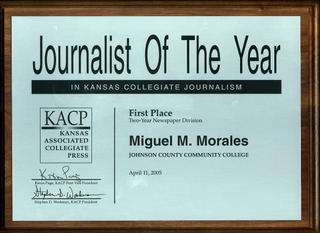Forget Jayson Blair, the real danger to the newsroom comes from seasoned journalists.
According to the Detroit Free Press, sports columnist and newsroom superstar, Mitch Albom, and other columnists for Free Press wrote several columns without properly attributing sources to other media, writing about events they never attended and fabricating events.
A few lessons from the latest journalism controversy:
- JOUR 122 - We know columns are not news or features but we should hold them to the same basic journalism standards as the rest of the paper. Also, sports gets away with a lot we don't tolerate in other sections of the paper. A sports round up is not a story. It is an extended sports brief. Sports uses clichés and inserts opinion. Yet, for some reason we make exceptions for this section based upon what we think readers want. Sports news should hold the same standard as a regular news. Sports features should be treated like a regular feature. And sports columns should meet the requirements of columns, commentaries and editorials on the opinon page.
- "Lifting" quotes is stealing - Just because they are words and not $20 bills doesn't mean we should excuse the practice.
- Attribute, attribute, attribute - I used to feel guilty about being an attribution tyrant by insisting reporters attribute information not commonly known fact by the reader. But this year I've come to embrace my inner tyrant and I'm glad we emphasize attributions.
- Be a skeptical editor - Ask the reporter where he or she found the information. If you don't see him or her working off notes or off a recorded interview, ask to see or hear the information. Newsroom superstars are not above the editing process or the copy desk. Experimenting with a new style is great. But a reporter must know the rules in order to creatively break them.
- Feed off feedback - The learning lab/newsroom allows us to examine ourselves (though we need to do a better job of soliciting reader feedback). Newsroom culture can help keep refocus renegade journalists while coaching reinforces good reporting. Our work with student journalists doesn't just produce a good product, it produces good reporters.
- Know and enforce ethics - A clear and enforceable code of ethics helps address these kinds of issues. My campus paper, The Campus Ledger, has an effective code of ethics as it is based on professional standards, and our college's personel policies and the student code of conduct.
- Codify unwritten rules - As our campus papers progress by incorporating professional standards, we need to evaluate, eliminate or codify unwritten rules and standing policies especially for situations like getting quotes from a televised press conference or quotes making the media roundtables that cannot be attributed to the original source (though who wants to use recycled quotes?).
- Peer review - Honor the integrity of the newsroom and respect the reporter in question by establish a formal process for reviewing situations like this. Don't wait until you have a kitchen fire to learn how to use a fire extinguisher.
- Newspapers aren't textbooks - We learn from reading and modeling good writers but when something doesn't sound right, go back to your journalism roots and verify. As we adapt good journalism from news media, learn how to spot and avoid bad journalism.
- As journalists our words are our currency - And thanks to some journalistic jackasses of late, the reader's trust costs more everyday.
I've come to the conclusion that the Free Press, a very well respected news organization, is screwed up. But they're screwed up in a way most news organizations are.
Fixated on the product and catering to newsroom superstars, managers ignore -- or worse, countermand-- procedures set in place to ensure quality.
As writing coach and an award-winning collgiate journalist including Journalist of the Year, I've had my ass kissed this year. But I've also had it kicked when I didn't produce to the minimum standard.
No one is above an edit.




